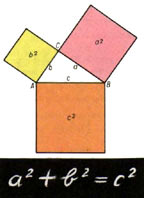
Many of us have seen the Pythagoras Theorem [a2+b2=c2] in
high school. It is a relational statement to solve an unknown; if we start with
a right triangle, and know any two sides, we can find the length of the third
side. The equation may not seem complex, but just how did Pythagoras, a famous
philosopher in his time, come up with the equation?
What about Pi, e, and imaginary numbers (e.g., the square root of minus one)?
These have no physical manifestation, yet they are all around us. How do we
calculate the circumference of a circle? We need Pi! Microorganisms’ exponential
growth can be defined by an equation involving e! What is the likelihood of
someone coming up with Pi and e by accident, trial and error, experiment or
observation?
Certainly intelligence combined with intuition. These laws and theorems which
govern nature were already there, around and within us, before they were
“uncovered”. These profound studies aid humans in perceiving and grasping at the
intelligence in nature, and enable us to express them through formulas and
symbols. They are not merely tools for building faster cars or more advanced
computers, but take humans on the first step towards a unification of the
fundamental forces of nature.
For Pythagoras, who founded the classical school of philosophy called the
Museum, contemplation of nature and natural rhythms is a tool for a higher
purpose – the supreme happiness of the human being, which lay within the human
soul and the integration of this soul in a harmonious dance with nature.